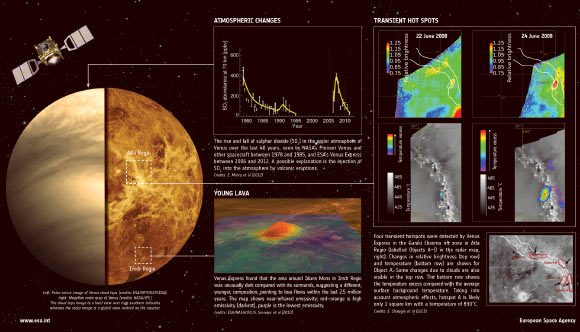By looking at data from the monitoring camera on ESA’s Venus Express spacecraft, planetary researchers found transient spikes in temperature at several spots on the Venusian surface. The hotspots, which were found to flash and fade over the course of just a few days, appear to be generated by lava flows on the planet’s surface.

Infographic summarizing three key pieces of evidence that can be explained by recent volcanic activity on Venus. Image credit: ESA.
Some models of planet evolution suggest volcanoes on Venus erupted around half a billion years ago. But whether the planet is active today has remained a hot topic in planetary science.
In a 2010 study, Dr Sue Smrekar of NASA’s Jet Propulsion Laboratory and co-authors reported that the infrared radiation coming from three volcanic regions on the planet was different to that from the surrounding terrain.
They interpreted this as coming from relatively fresh lava flows that had not yet experienced significant surface weathering. These flows were found to be less than 2.5 million years old, but the study could not establish whether there is still active volcanism on the planet.
An additional piece of evidence was reported in 2012 by Dr Emmanuel Marcq of Laboratoire Atmosphères in Milieux and co-authors, showing a sharp rise in the sulfur dioxide content of the Venus’ upper atmosphere in 2006-2007. Although changes in wind patterns could have caused this, the more intriguing possibility is that episodes of volcanic activity were injecting vast amounts of sulfur dioxide into the planet’s atmosphere.
Now, a team of scientists led by Dr Eugene Shalygin of the Max Planck Institute, Germany, has spotted localized changes in surface brightness between images taken by the Venus Express’ camera only a few days apart. The data showed spikes in temperature of several hundred degrees Fahrenheit in spots ranging in size from 1 square km to over 200 km.
The spots were clustered in a large rift zone called Ganiki Chasma close to the volcanoes Ozza Mons and Maat Mons. Rift zones are results of fracturing of the surface, which is often associated with upwelling of magma below the crust. This process can bring hot material to the surface, where it may be released through fractures as a lava flow.
The Ganiki Chasma rift zone was already considered to be one of the most recently geologically active regions on the planet, and as the new study suggests, it is still active today.
“We knew that Ganiki Chasma was the result of volcanism that had occurred fairly recently in geological terms, but we didn’t know if it formed yesterday or was a billion years old. The active anomalies detected by Venus Express fall exactly where we had mapped these relatively young deposits and suggest ongoing activity,” said team member Dr James Head of Brown University.
“This discovery fits nicely with the emerging picture of very recent activity in Venus’ geologic history.”
“It looks like we can finally include Venus in the small club of volcanically active Solar System bodies,” said Dr Håkan Svedhem of ESA.
“Our study shows that Venus, our nearest neighbor, is still active and changing in the present day – it is an important step in our quest to understand the different evolutionary histories of Earth and Venus.”
The results of this study were published online in the journal Geophysical Research Letters.
_____
E.V. Shalygin et al. Active volcanism on Venus in the Ganiki Chasma rift zone. Geophysical Research Letters, published online May 23, 2015; doi: 10.1002/2015GL064088








